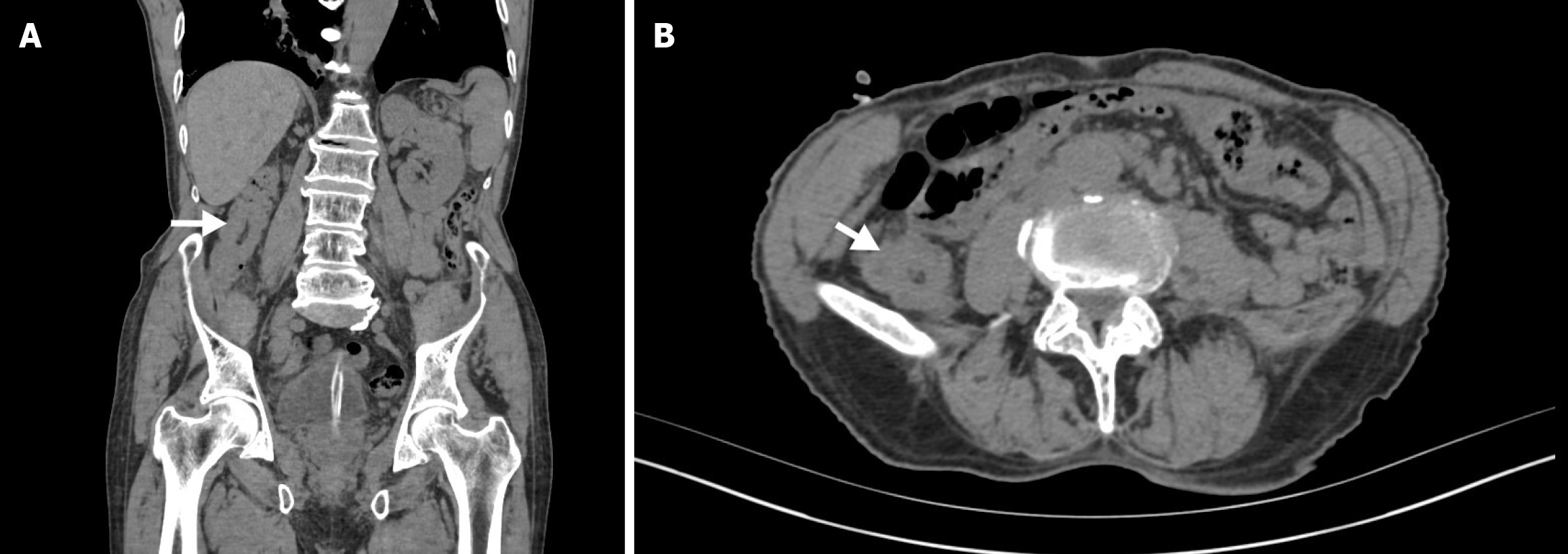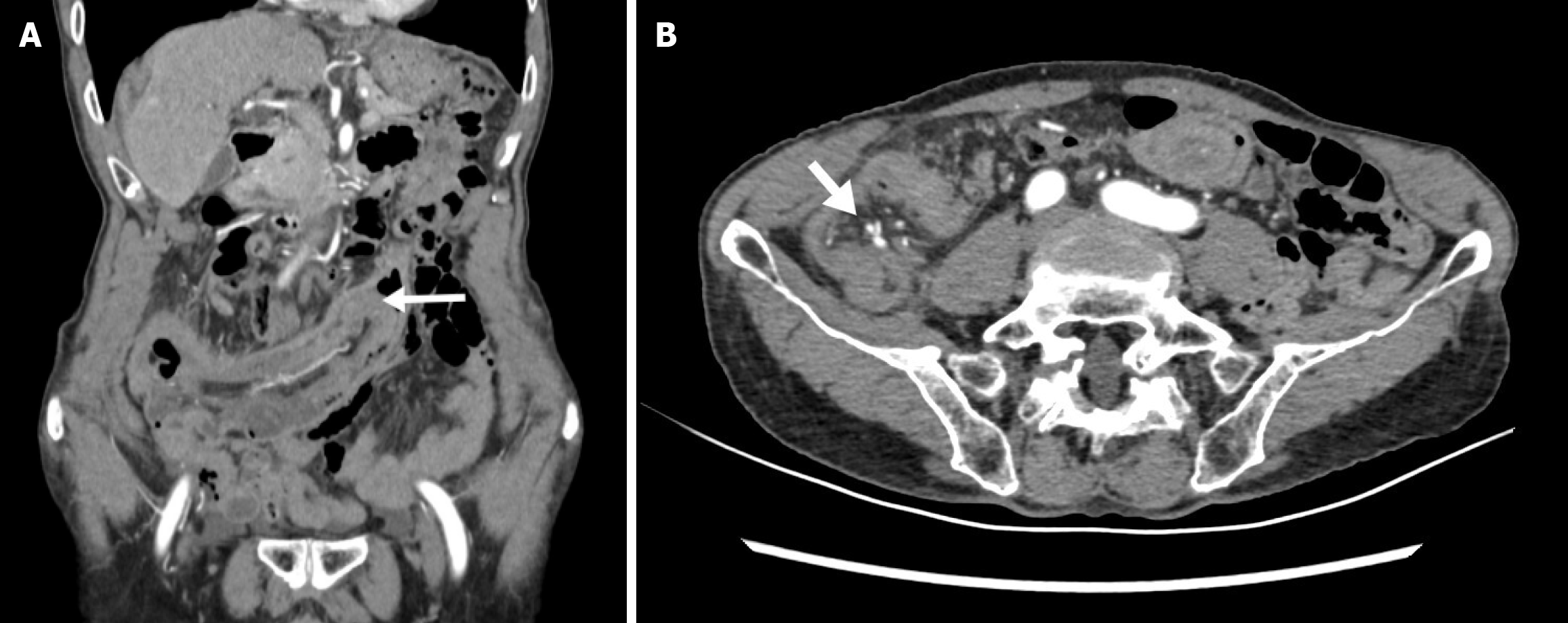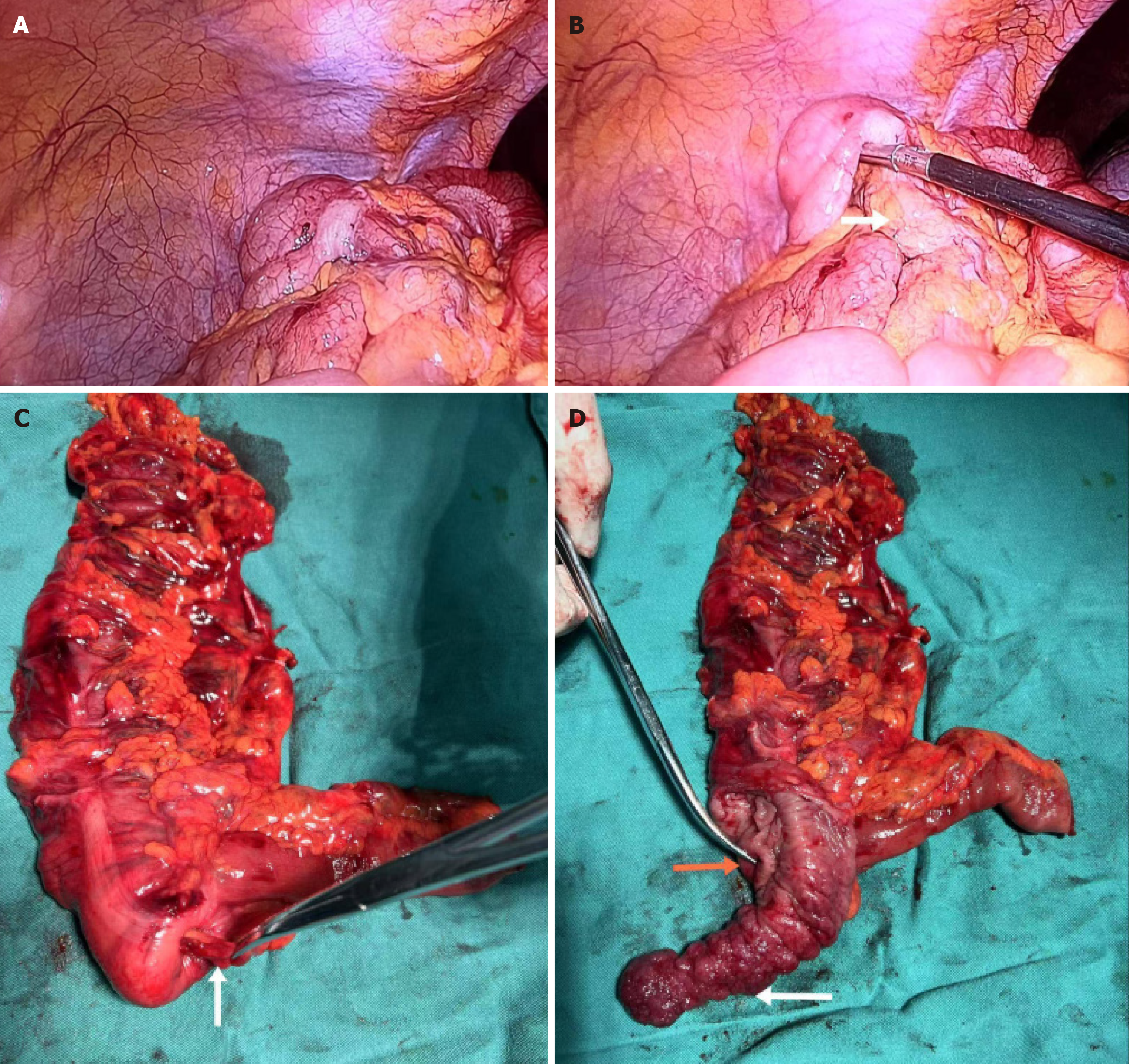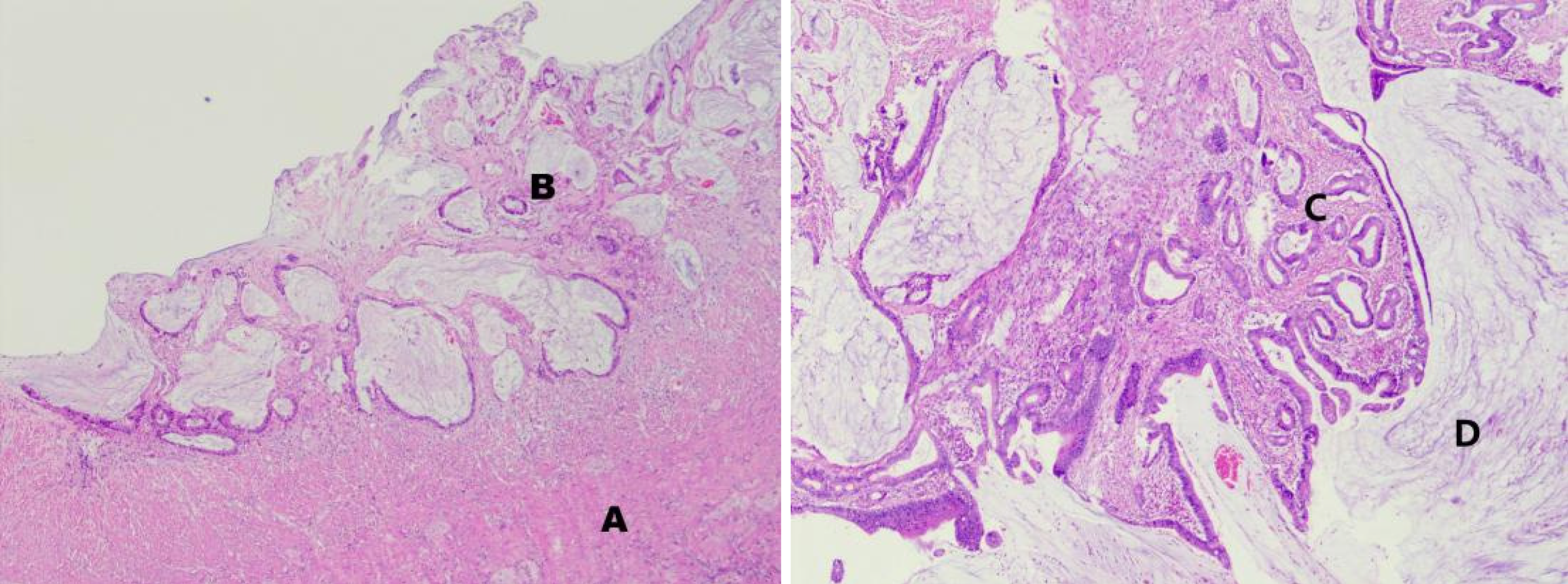Published online Sep 27, 2025. doi: 10.4240/wjgs.v17.i9.109320
Revised: June 8, 2025
Accepted: July 18, 2025
Published online: September 27, 2025
Processing time: 140 Days and 6.4 Hours
Complete appendiceal intussusception (CAI) coexisting with appendiceal tumor represents an exceptionally rare clinical tumor. This study presented a retro
A 74-year-old male patient presented with abdominal pain. Abdominal contrast-enhanced computed tomography (CECT) initially suggested a colonic tumor with intussusception. Colonoscopy identified a mass in the colon 60 cm from the anus. Intraoperative exploration confirmed CAI secondary to an appendiceal neoplasm. The patient underwent laparoscopic right hemicolectomy with regional lym
Plain abdominal computed tomography may underestimate the presence of CAI and appendiceal mucinous tumor, whereas CECT significantly improves diag
Core Tip: Complete appendiceal intussusception (CAI) and appendiceal mucinous adenocarcinoma (AMA) is an extremely rare condition, which has not been reported in PubMed, and the preoperative diagnosis of this disease lacks specificity and is very easy to misdiagnose. This article summaries the clinical experience and lessons learned for the diagnosis and management of this disease. The main contributions include: (1) Novelty or clinical significance: First reported case of CAI and AMA in PubMed; (2) Educational value, providing insight into the diagnostic pitfalls and surgical decisions of CAI and AMA; and (3) A definite preoperative diagnosis can avoid secondary surgery.
- Citation: Guo Q, Lu HY, Lyu H, Tian H, Zhao Q, Zheng YC. Complete appendiceal intussusception and appendiceal mucinous tumor: A case report and review of literature. World J Gastrointest Surg 2025; 17(9): 109320
- URL: https://www.wjgnet.com/1948-9366/full/v17/i9/109320.htm
- DOI: https://dx.doi.org/10.4240/wjgs.v17.i9.109320
Appendiceal neoplasms have historically been regarded as an exceedingly rare condition, with an annual incidence of only 0.12 cases per million individuals as reported in studies from the United States. Recent investigations in North America and Europe have shown a significant increase in the incidence of appendiceal tumors, with the highest recorded rate reaching 0.97 cases per 100000 persons[1]. These neoplasms constitute roughly 5% of gastrointestinal tumors[2], and remain among the rarest malignant tumors worldwide. Primary appendiceal tumor was first documented by Berger in 1882[3].
Histologically, primary appendiceal tumors are typically categorized into three main subtypes: (1) Colonic-type tumor; (2) Mucinous tumors; and (3) Signet-ring cell carcinoma[4]. Appendiceal tumor can be further subclassified into non-mucinous tumor, mucinous tumor, signet-ring cell tumor, and undifferentiated carcinoma[5]. Intussusception arises from multiple etiologies; while the etiology of intussusception in children remains unclear, potential contributing factors include abnormal intestinal motility, anatomical predispositions, and infections processes[6,7]. In adults, intussusception can occur in both the small bowel and colon, most frequently secondary to intestinal neoplasms[8,9], with rare reports following gastrointestinal surgeries[10].
Complete appendiceal intussusception (CAI) represents a rare anatomical variation, and its association with malignancy complicating CAI is even rarer. The study aims to present a rare case of CAI secondary to appendiceal mucinous tumor. Additionally, a comprehensive literature review was performed to summarize the clinical approach and management strategies.
The patient was a 74-year-old Asian male, with primary school education, and married. Abdominal pain and diarrhoea for 1 month.
One month prior to admission, the patient developed persistent dull abdominal pain accompanied by increased bowel frequency (about 7-8 times/day), with alternating yellow watery and black stools.
The patient had a history of chronic obstructive pulmonary disease.
Negative family history for gastrointestinal malignancies.
Physical examination revealed right lower quadrant tenderness without palpable mass. Bowel sounds were audible, and there was no shifting dullness.
Carcinoembryonic antigen (CEA) and carbohydrate antigen 19-9 were within normal limits.
Abdominal plain computed tomography (CT) on August 22, 2023 (Figure 1) demonstrated ascending colon wall thickening. Treatment included bowel preparation and nutritional support. Colonoscopy on August 24, 2023 revealed a mass located 60 cm from the anus, which obstructed endoscopic passage. Biopsy showed severe atypical hyperplasia with suspicion for carcinoma. Abdominal contrast-enhanced CT on August 29, 2023 (Figure 2) showed ileocecal structural distortion and intestinal wall thickening with a “concentric rings” sign. Mesenteric vascular engorgement extended into the transverse colon, with localized bowel wall enhancement, suspicious for intussusception with inflammatory changes and possible space-occupying lesion.
The preoperative diagnosis was colonic tumor with intestinal intussusception. On August 29, 2023, the patient underwent laparoscopic right hemicolectomy with regional lymphadenectomy under general anaesthesia. Intraoperative findings (Figure 3A and B) demonstrated intussusception of the ileum, appendix, and ileocecal region into the ascending colon, which could not be fully reduced. The appendix was not grossly identified, though a “belly-button” like change was observed (Figure 3C). The remaining colon showed no abnormalities on inspection. Postoperative specimen examination revealed complete invagination of the appendix into the lumens of the cecum and ascending colon. The appendix and its mesentery were invaginated into the cecum and ascending colon, and the mucosa of the appendix showed a 3–5 mm polypoid tumor. The appendix measured approximately 7 cm in length and 3 cm in diameter, with blood supply maintained by the ileocolic artery (Figure 3D).
CAI and Appendiceal Mucinous tumor (pT4aN0M0 stage IIb). Postoperatively, the patient was given treatments for infection prevention and nutritional support. Monitored with notable recovery after surgery, the patient was discharged in stable condition. Twelve-month follow-up revealed no clinical, radiological, or laboratory evidence of tumor recurrence or metastasis.
The patient underwent laparoscopic right hemicolectomy with regional lymphadenectomy under general anaesthesia.
Postoperative pathology of the right hemicolectomy specimen showed the appendix prolapsing into the ileocecal lumen, with villous adenomatous changes in the mucosa. Focal mucinous tumor (1.0 cm × 0.5 cm) was identified, invading the serosal without vascular or neural involvement. Omental margins were free of malignancy (Figure 4). Twenty-one pericolic lymph nodes showed no metastatic disease. Cancer cells were creatine kinase (+), CEA (+), P53 (wild-type), MLH1 (+), MSH2 (+), MSH6 (+), PMS2 (+), Ki67 (+ approximately 30%). Twelve-month follow-up revealed no clinical, radiological, or laboratory evidence of tumor recurrence or metastasis.
A systematic search of PubMed and EMBASE databases using the search terms “appendiceal cancer AND complete appendiceal intussusception” retrieved 10 case reports of CAI associated with appendiceal malignancy (Table 1)[11-20]. Notably, only one prior case described CAI secondary to appendiceal mucinous carcinoma, while the present case represents the first report of CAI due to appendiceal mucinous tumor in PubMed. Including this case, a total of 11 cases of CAI with appendiceal cancer have been documented, demonstrating significant preoperative diagnostic challenges: (1) 4 cases were misdiagnosed as cecal tumors; (2) 3 cases as cecal polyps; (3) 1 case as colon cancer; and (4) 2 cases had an unclear preoperative diagnosis. Only 1 case was correctly diagnosed as appendiceal cancer preoperatively, resulting in misdiagnosis rate of 90.91%.
| No. | Age/sex | Pathology | TNM stage | Surgical method | Preoperative diagnosis | Examination items | Year | Ref. |
| 1 | 74 years old/female | Appendiceal tumor | Unknown | Laparoscopic right hemicolectomy | Unknown | Barium enema + enteroscope | 1994 | Schmidt et al[15] |
| 2 | 64 years old/female | Appendiceal tubular adenoma with tumor | pTisN0M0 | Ileocecal resection | Cecal polyp | Barium enema + enteroscope | 1995 | Sakaguchi et al[16] |
| 3 | 67 years old/male | Appendiceal tubular adenoma with tumor | pTisN0M0 | Right hemicolectomy + regional lymph node dissection | Cecal tubular villous adenoma with tumor | Barium enema + abdominal CT + enteroscope | 2000 | Ohno et al[17] |
| 4 | 49 years old/male | Appendiceal tubular adenoma with tumor | pTisN0M0 | Ileocecal resection + regional lymph node dissection | Appendiceal cancer | Barium enema + abdominal CT + enteroscope | 2003 | Takahashiet al[14] |
| 5 | 84 years old/female | Appendiceal tubular adenoma with tumor | Unknown | Right hemicolectomy | Unknown | Barium enema + abdominal CT | 2003 | Fujii[18] |
| 6 | 79 years old/female | Appendiceal mucinous tumor with peritoneal metastasis | pT3N0M1 | Ileocecal resection + regional lymph node dissection | Advanced cecal tumor | Abdominal ultrasound + abdominal CT + enteroscope | 2005 | Iwakawa et al[12] |
| 7 | 26 years old/male | Appendiceal tubular adenoma with tumor | pTisN0M0 | Ileocecal resection + regional lymph node dissection | Cecal cancer | Abdominal CT + enteroscope | 2014 | Matsushita et al[19] |
| 8 | 32 years old/female | Appendiceal tumor | Unknown | Right hemicolectomy | Cecal polyp | Abdominal enhanced CT + enteroscope | 2016 | Kawakami et al[20] |
| 9 | 76 years old/female | Appendiceal tubular adenoma with tumor | pTisN0M0 | Ileocecal resection + regional lymph node dissection | Cecal cancer | Abdominal enhanced CT + enteroscope | 2021 | Kasetani et al[11] |
| 10 | Unknown | Appendiceal tumor | pT2nxmx | Endoscopic thermal loop ligation appendectomy + laparoscopic right hemicolectomy | Cecal polyp | Abdominal CT + enteroscope | 2024 | Ramirez et al[13] |
| This case | 74 years old/male | Appendiceal mucinous tumor | pT3N0M0 | Laparoscopic right hemicolectomy + regional lymph node dissection | Colon tumor | Abdominal enhanced CT + enteroscope |
Primary appendiceal tumor typically occurs at the appendiceal base. The narrow appendiceal lumen predisposes to obstruction by small neoplasms, with low-grade tumors often occluding the appendiceal orifice in early disease stages, leading to secondary inflammation[21]. Furthermore, the appendix lacks well-developed longitudinal and circular muscle fibers, a feature that not only facilitates rapid tumor expansion and perforation but also promotes early intraperitoneal dissemination. Consequently, peritoneal metastasis occurs more frequently than hematogenous or lymphatic spread. The nonspecific clinical symptoms of appendiceal cancer, including abdominal pain and altered bowel habits, hinders preoperative diagnosis, with malignancy often confirmed incidentally through pathological examination of ap
Esmer-Sánchez et al[22] reported that 55%-90% of patients with primary appendiceal tumor presented preoperatively with acute appendicitis. In this case, unenhanced abdominal plain CT demonstrated ascending colon wall thickening, which was prone to misdiagnosis as a colon tumor. Contrast-enhanced abdominal CT imaging showed tubular sounds in the cecum, ascending colon, and transverse colon, with visible vascular signs. Preoperative consideration was given to intussusception, with the bowel and mesentery intussuscepted into the colon. This radiological presentation is consistent with the imaging findings reported in cases by Kasetani et al[11], where enhanced abdominal CT offers an advantage for a more definitive diagnosis.
Imaging examinations play an important role in diagnosing appendiceal cancer within the cecal lumen, but there are also certain limitations. In a case report by Zhang et al[23], abdominal CT suggested a tumor-like lesion in the right mid-abdomen, initially interpreted as a colonic tumor. Colonoscopy was incomplete due to patient discomfort, failing to reach the ileocecal valve, but revealed a friable, purplish-red mass in the ascending colon 65-70 cm from the anus, raising suspicion for colon cancer. The abdominal CT and colonoscopy findings in this case were similar to those in the report by Zhang et al[23], with the difference being that Zhang et al’s case[23] did not show any signs of intussusception or cancer in the appendix. The preoperative diagnosis was incorrect in both cases.
Abdominal CT can effectively show the site, type, and length of intussusception, aiding preliminary assessment of its etiology. In particular, dynamic enhancement and multi-plane reconstruction are more valuable for clinical diagnosis and treatment[24-26]. The American guidelines for appendiceal tumors designate abdominal CT and abdominal magnetic resonance imaging as preferred diagnostic tests for appendiceal tumors[1]. Given the 13%-42% risk of concurrent colorectal tumors in appendiceal tumor patients, colonoscopy is integral to preoperative or postoperative evaluation[27-29]. While unenhanced abdominal CT may lead to misdiagnosis, contrast-enhanced CT mitigates this risk.
In the reported cases, only Iwakawa et al[12] described a patient with peritoneal metastasis, who underwent ileocecal resection and D1 Lymph node dissection. The patient died 1 year and 7 months postoperatively due to disease progression. This patient alone showed preoperative CEA elevation, consistent with studies indicating that tumor markers like CEA often rise in advanced patients, indicating poor prognosis[5,30].
There are many classifications of appendiceal tumors, and treatment approaches and prognosis vary significantly between different types. Therefore, the pathology of appendiceal tumors is very important. Preoperative pathological methods include colonoscopic biopsy and intraoperative frozen section. In the absence of a colonoscopic biopsy, intraoperative frozen section becomes crucial in determining the surgical approach, resection range, and ensuring negative margins[1]. There has been ongoing debate regarding the extent of appendiceal tumor resection. The Italian Society of Surgical Oncology’s Peritoneal Malignant Tumor Group recommends right hemicolectomy for non-perforated ap
In this case and 6 prior reports, right hemicolectomy with regional lymph node dissection was performed, while 5 cases underwent ileocecal resection with regional lymph node dissection. In this case, since a colonoscopic biopsy had already been performed preoperatively, intraoperative frozen section examination was not conducted. No appendiceal tumor perforation or peritoneal metastatic lesions were found during surgery. Therefore, right hemicolectomy with regional lymph node dissection was performed, and HIPEC was not administered.
The vermiform appendix demonstrates numerous congenital anomalies. Embryologically and anatomically, any developmental deviations in structure, number, morphology, size, or positional relationship are defined as appendiceal variations. These anomalies are typically classified into four major categories: (1) Appendiceal malformations (specifically referring to morphological and numerical abnormalities); (2) Ectopic appendiceal tissue (characterized by aberrant mucosal deposits); (3) Ectopic appendix (denoting abnormal positional development); and (4) Developmental abnor
In a study of 779 cases of ectopic appendices, 3 cases (0.4%) were found with appendices located within the cecal lumen[33]. Based on anatomical features, McSwain[34] classified appendiceal intussusception into five types, defining type V as complete invagination of the entire appendix into the cecum. This case exhibits multiple variations, being both an appendiceal developmental abnormality and an ectopic appendix. CAI is clinically uncommon, with non-specific symptoms that may mimic other gastrointestinal disorders, often leading to misdiagnoses as cecal polyps or cecal tumors. This diagnostic challenge underscores the importance of clinicians exercising caution during the diagnostic process. Misdiagnosed cases serve as a constant reminder for careful consideration in diagnosis
Areas for further investigation: The pathogenesis and risk factors of CAI with malignancy are still unclear and require more basic research and epidemiological investigations. Areas of insufficient experience: Abdominal enhanced CT shows that the extent of appendiceal intussusception complicated by bowel intussusception has reached the transverse colon. When performing right hemicolectomy after surgical reduction, the potential risk of tumor cell dissemination during the reduction process requires careful assessment. Strategies to improve the early diagnosis of malignancy in CAI, especially in terms of improvements in imaging and endoscopic examination, require further research. Review of previously reported cases revealed that Ramirez et al[13] described a combined approach of endoscopic thermal loop ligation of the appendix combined with laparoscopic right hemicolectomy, which provides a new approach to improving the accuracy and timeliness of diagnosis.
The diagnosis of CAI complicated by mucinous tumor is challenging preoperatively due to its nonspecific clinical features. It is often misdiagnosed as cecal polyps, colon tumors, or bowel intussusception. Re-operative evaluation should integrate comprehensive analysis of clinical symptoms, physical findings, and auxiliary examinations. While plain abdominal CT may yield false-negative results, contrast-enhanced abdominal CT significantly improves diagnostic accuracy by visualizing characteristic features. For cases of CAI, appendiceal neoplasms should be prioritized in the differential diagnosis. In the absence of confirmatory colonoscopic biopsy, intraoperative pathological evaluation is recommended to facilitate definitive diagnosis and enable primary radical resection.
I would like to thank all the staff of Department of Pathology and Department of Medical Record, Ya'an People's Hospital for providing convenient conditions for implementing this study.
| 1. | Rossi A, Maloney Patel N. Appendiceal neoplasms-A practical guide. J Surg Oncol. 2023;127:1300-1305. [RCA] [PubMed] [DOI] [Full Text] [Cited by in RCA: 16] [Reference Citation Analysis (0)] |
| 2. | Loftus TJ, Raymond SL, Sarosi GA Jr, Croft CA, Smith RS, Efron PA, Moore FA, Brakenridge SC, Mohr AM, Jordan JR. Predicting appendiceal tumors among patients with appendicitis. J Trauma Acute Care Surg. 2017;82:771-775. [RCA] [PubMed] [DOI] [Full Text] [Cited by in Crossref: 31] [Cited by in RCA: 59] [Article Influence: 6.6] [Reference Citation Analysis (0)] |
| 3. | Berger A. Ein fall von krebs des wurmfortsatzes. Berl Klin Woche. 1882;19:616-618. |
| 4. | Van de Moortele M, De Hertogh G, Sagaert X, Van Cutsem E. Appendiceal cancer: a review of the literature. Acta Gastroenterol Belg. 2020;83:441-448. [PubMed] |
| 5. | Köhler F, Matthes N, Rosenfeldt M, Kunzmann V, Germer CT, Wiegering A. Neoplasms of the Appendix. Dtsch Arztebl Int. 2023;120:519-525. [RCA] [PubMed] [DOI] [Full Text] [Cited by in RCA: 9] [Reference Citation Analysis (0)] |
| 6. | Neeser HR, Tharakan SJ. Intussusception. In: Mattei P, editor. Fundamentals of Pediatric Surgery. Berlin: Springer, 2022. [DOI] [Full Text] |
| 7. | Attoun MA, Albalawi SMD, Ayoub A, Alnasser AK, Alkaram EH, Khubrani FA, Alzahrani KJ, Alatawi KA, Almutairi N, Alnami AG. The Management of Intussusception: A Systematic Review. Cureus. 2023;15:e49481. [RCA] [PubMed] [DOI] [Full Text] [Cited by in RCA: 9] [Reference Citation Analysis (0)] |
| 8. | T Chand J, R R, Ganesh MS. Adult intussusception: a systematic review of current literature. Langenbecks Arch Surg. 2024;409:235. [RCA] [PubMed] [DOI] [Full Text] [Cited by in RCA: 13] [Reference Citation Analysis (0)] |
| 9. | Álvarez-Bautista FE, Moctezuma-Velázquez P, Pimienta-Ibarra AS, Vergara-Fernández O, Salgado-Nesme N. Adult intussusception: still a challenging diagnosis for the surgeon. Rev Gastroenterol Mex (Engl Ed). 2023;88:315-321. [RCA] [PubMed] [DOI] [Full Text] [Cited by in Crossref: 1] [Cited by in RCA: 3] [Article Influence: 1.0] [Reference Citation Analysis (0)] |
| 10. | Freitas D, Saunders J, Parikh M. Gastrogastric and Gastroduodenal Intussusception After Gastric Plication. Obes Surg. 2024;34:3924-3925. [RCA] [PubMed] [DOI] [Full Text] [Cited by in RCA: 3] [Reference Citation Analysis (0)] |
| 11. | Kasetani T, Hirata H, Morita T, Furukawa H. [A Case of Appendiceal Intussusception Induced by Early Appendiceal Carcinoma]. Gan To Kagaku Ryoho. 2021;48:1728-1730. [PubMed] |
| 12. | Iwakawa K, Tanaka H, Sugiyama K, Ichikawa M, Kajiwara S, Kurihara K. Complete appendiceal intussusceotion inditced by appendiceal carcinoma associated with localized peritoneal dissemination. Gastroenterol Endosc. 2005;47:2664-2669. [DOI] [Full Text] |
| 13. | Ramirez R, Buchberg B, Ricketts P, Ramirez R. A Combined Endoscopiclaparoscopic Surgical (CELS) Approach for A Rare Appendiceal Pathology, Annual Scientific Meeting of the American Society of Colon and Rectal Surgeons, ASCRS 2024. Dis Colon Rectum. 2024;. |
| 14. | Takahashi M, Sawada T, Fukuda T, Furugori T, Kuwano H. Complete appendiceal intussusception induced by primary appendiceal adenocarcinoma in tubular adenoma: a case report. Jpn J Clin Oncol. 2003;33:413-415. [RCA] [PubMed] [DOI] [Full Text] [Cited by in Crossref: 22] [Cited by in RCA: 16] [Article Influence: 0.7] [Reference Citation Analysis (0)] |
| 15. | Schmidt JS, Maier D, Raj P, Remine SG. Laparoscopic management of appendiceal intussusception associated with villous adenocarcinoma. J Laparoendosc Surg. 1994;4:369-373. [RCA] [PubMed] [DOI] [Full Text] [Cited by in Crossref: 11] [Cited by in RCA: 10] [Article Influence: 0.3] [Reference Citation Analysis (0)] |
| 16. | Sakaguchi N, Ito M, Sano K, Baba T, Koyama M, Hotchi M. Intussusception of the appendix: a report of three cases with different clinical and pathologic features. Pathol Int. 1995;45:757-761. [RCA] [PubMed] [DOI] [Full Text] [Cited by in Crossref: 30] [Cited by in RCA: 20] [Article Influence: 0.6] [Reference Citation Analysis (0)] |
| 17. | Ohno M, Nakamura T, Hori H, Tabuchi Y, Kuroda Y. Appendiceal intussusception induced by tubulovillous adenoma with carcinoma in situ: report of a case. Surg Today. 2000;30:441-4. [RCA] [PubMed] [DOI] [Full Text] [Cited by in Crossref: 12] [Cited by in RCA: 6] [Article Influence: 0.2] [Reference Citation Analysis (0)] |
| 18. | Fujii O, Sakaguchi T, Sugimura K, Hori H, Fujita T, Adachi M, Toshima K, Akematsu T. Complete intussusception induced by appendiceal cancer; report of a case. Jpn J Clin Radiol. 2003;48:949-952. |
| 19. | Matsushita K, Kagawa Y, Kato T, Sakisaka H, Sato Y, Morimoto Y, Kusama H, Hashimoto T, Kimura K, Mukai Y, Kawashima H, Katsura Y, Nitta K, Okishiro M, Takeno A, Nakahira S, Taniguchi H, Egawa C, Takeda Y, Tamura S. [A case of appendiceal intussusception induced by appendiceal carcinoma]. Gan To Kagaku Ryoho. 2014;41:1628-1630. [PubMed] |
| 20. | Kawakami K, Hara A, Henmi Y, Naka Y, Hirata Y, Okada T, Kakimoto K, Takeuchi T, Fukunishi S, Higuchi K. Complete appendiceal intussusception induced by primary appendiceal adenocarcinoma, Asia Pacific Digestive Week, APDW 2016. J Gastroenterol Hepatol. 2016;. |
| 21. | McGory ML, Maggard MA, Kang H, O'Connell JB, Ko CY. Malignancies of the appendix: beyond case series reports. Dis Colon Rectum. 2005;48:2264-2271. [RCA] [PubMed] [DOI] [Full Text] [Cited by in Crossref: 176] [Cited by in RCA: 179] [Article Influence: 8.5] [Reference Citation Analysis (0)] |
| 22. | Esmer-Sánchez DD, Martínez-Ordaz JL, Román-Zepeda P, Sánchez-Fernández P, Medina-González E. [Appendiceal tumors. Clinicopathologic review of 5,307 appendectomies]. Cir Cir. 2004;72:375-378. [PubMed] |
| 23. | Zhang L, Wang QS, Liu Q, Cai JH, Huang K, Zhu ZP. [A case of cecal intussusception with misdiagnosis of colon tumor]. Yinanbing Zazhi. 2014;792. [DOI] [Full Text] |
| 24. | Miller J, Shukla S, Baigorri B, Tejero H. CT diagnosis of appendiceal intussusception in a middle-aged female. J Radiol Case Rep. 2020;14:8-14. [RCA] [PubMed] [DOI] [Full Text] [Cited by in Crossref: 2] [Cited by in RCA: 4] [Article Influence: 0.7] [Reference Citation Analysis (0)] |
| 25. | Xu AL. [Clinical significance of multi-slice spiral CT in adult bowel intussusception]. Yingxiang Yanjiu Yu Yixue Yingyong. 2019;3:207-208. |
| 26. | Milošević S, Bubanja M, Zugic A, Mitrovic M, Stosic K, Tosic V, Vasin D, Djuric-Stefanovic A. Appendiceal Intussusception: A Rare Diagnosis and the Role of Imaging in Its Detection. Diagnostics (Basel). 2025;15:256. [RCA] [PubMed] [DOI] [Full Text] [Cited by in RCA: 1] [Reference Citation Analysis (0)] |
| 27. | Lohsiriwat V, Vongjirad A, Lohsiriwat D. Incidence of synchronous appendiceal neoplasm in patients with colorectal cancer and its clinical significance. World J Surg Oncol. 2009;7:51. [RCA] [PubMed] [DOI] [Full Text] [Full Text (PDF)] [Cited by in Crossref: 18] [Cited by in RCA: 19] [Article Influence: 1.1] [Reference Citation Analysis (0)] |
| 28. | Khan MN, Moran BJ. Four percent of patients undergoing colorectal cancer surgery may have synchronous appendiceal neoplasia. Dis Colon Rectum. 2007;50:1856-1859. [RCA] [PubMed] [DOI] [Full Text] [Cited by in Crossref: 28] [Cited by in RCA: 29] [Article Influence: 1.5] [Reference Citation Analysis (0)] |
| 29. | Benedetti M, Tinozzi FP, Dini S, Albertario S, Rossi G, Bianchi C, Tinozzi S. [Synchronous and metachronous tumours of colon cancer. A review of 5 years of experience (1999-2004)]. Ann Ital Chir. 2006;77:233-239. [PubMed] |
| 30. | Matias-García B, Mendoza-Moreno F, Blasco-Martínez A, Busteros-Moraza JI, Diez-Alonso M, Garcia-Moreno Nisa F. A retrospective analysis and literature review of neoplastic appendiceal mucinous lesions. BMC Surg. 2021;21:79. [RCA] [PubMed] [DOI] [Full Text] [Full Text (PDF)] [Cited by in Crossref: 4] [Cited by in RCA: 16] [Article Influence: 3.2] [Reference Citation Analysis (0)] |
| 31. | Vaira M, Robella M, Guaglio M, Berchialla P, Sommariva A, Valle M, Pasqual EM, Roviello F, Framarini M, Fiorentini G, Sammartino P, Ilari Civit A, Di Giorgio A, Ansaloni L, Deraco M. Diagnostic and Therapeutic Algorithm for Appendiceal Tumors and Pseudomyxoma Peritonei: A Consensus of the Peritoneal Malignancies Oncoteam of the Italian Society of Surgical Oncology (SICO). Cancers (Basel). 2023;15:728. [RCA] [PubMed] [DOI] [Full Text] [Full Text (PDF)] [Cited by in RCA: 16] [Reference Citation Analysis (0)] |
| 32. | Chicago Consensus Working Group. The Chicago Consensus on peritoneal surface malignancies: Management of appendiceal neoplasms. Cancer. 2020;126:2525-2533. [RCA] [PubMed] [DOI] [Full Text] [Cited by in Crossref: 52] [Cited by in RCA: 57] [Article Influence: 9.5] [Reference Citation Analysis (0)] |
| 33. | Xu ED, Yang LH. [Embryonic development of the appendix and ectopic appendix]. Shiyong Waike Zazhi. 1992;194-197. |
| 34. | Mcswain B. Intussusception of the appendix. South Med J. 1941;34:263-270. |
















